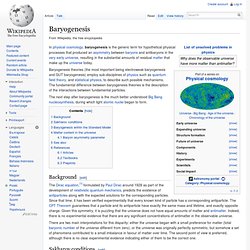

Baryogenesis. In physical cosmology, baryogenesis is the generic term for hypothetical physical processes that produced an asymmetry between baryons and antibaryons in the very early universe, resulting in the substantial amounts of residual matter that make up the universe today.

Baryogenesis theories (the most important being electroweak baryogenesis and GUT baryogenesis) employ sub-disciplines of physics such as quantum field theory, and statistical physics, to describe such possible mechanisms. The fundamental difference between baryogenesis theories is the description of the interactions between fundamental particles. The next step after baryogenesis is the much better understood Big Bang nucleosynthesis, during which light atomic nuclei began to form. Background[edit] The Dirac equation,[1] formulated by Paul Dirac around 1928 as part of the development of relativistic quantum mechanics, predicts the existence of antiparticles along with the expected solutions for the corresponding particles. Antimatter. In particle physics, antimatter is material composed of antiparticles, which have the same mass as particles of ordinary matter but have opposite charge and other particle properties such as lepton and baryon number.

Encounters between particles and antiparticles lead to the annihilation of both, giving rise to varying proportions of high-energy photons (gamma rays), neutrinos, and lower-mass particle–antiparticle pairs. Setting aside the mass of any product neutrinos, which represent released energy which generally continues to be unavailable, the end result of annihilation is a release of energy available to do work, proportional to the total matter and antimatter mass, in accord with the mass-energy equivalence equation, E=mc2.[1] From Fermilab, a New Clue to Explain Human Existence? - NYTimes.
In a mathematically perfect universe, we would be less than dead; we would never have existed.

According to the basic precepts of Einsteinian relativity and quantum mechanics, equal amounts of matter and antimatter should have been created in the Big Bang and then immediately annihilated each other in a blaze of lethal energy, leaving a big fat goose egg with which to make stars, galaxies and us. And yet we exist, and physicists (among others) would dearly like to know why. Sifting data from collisions of protons and antiprotons at Fermilab’s Tevatron, which until last winter was the most powerful particle accelerator in the world, the team, known as the DZero collaboration, found that the fireballs produced pairs of the particles known as muons, which are sort of fat electrons, slightly more often than they produced pairs of anti-muons. So the miniature universe inside the accelerator went from being neutral to being about 1 percent more matter than antimatter.